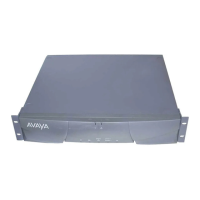SNI-BD (SNI Circuit Pack)
Issue 1 May 2002
8-1429555-233-143
SNI-BD (SNI Circuit Pack)
The TN573 Switch Node Interface (SNI) circuit pack is part of the Center Stage
Switch (CSS) configuration. It resides in a switch note carrier that alone or with
other switch nodes make up a CSS. SNIs connect to other SNIs or Expansion
Interface (EI) circuit packs via fiber links. SNI-to-EI fiber links are used to connect
port networks to a switch node carrier and SNI-to-SNI fiber links are used as
inter-switch node fibers. In critical-reliability systems, the fiber link connections
are duplicated as part of port-network connectivity (PNC) duplication. In
standard- and high-reliability systems, the PNC is not duplicated.
There may be up to 16 SNIs in a switch node carrier. They are located in slots 2
through 9 and slots 13 through 20. Slot 11 in a switch node carrier is not used.
One or two TN572 boards (SNCs) must reside in switch node carrier positions 10
and 12. The SNIs connect to other SNIs in the same carrier via the backplane;
these connections within the same carrier are referred to as peer-links. Each SNI
also connects via an optical fiber or metallic connection to another SNI in another
carrier or to an EI in an Expansion Port Network (EPN). These connections are
referred to as fiber links.
The Switch Node Clock (SNC) provides timing for the SNIs in the entire carrier.
When two SNCs reside in the same switch node carrier, one is in active mode and
one is in standby mode. The yellow LED on the active SNC will be on solid. The
yellow LED on the standby SNC will be off. See ‘‘SYNC (Port-Network
Synchronization)’’ for an explanation of how SNIs are involved in timing
synchronization.
Figure 8-81 on page 8-1430 shows an unduplicated CSS with one switch node. A
single switch node can accommodate up to 16 port networks. A system with two
switch nodes can accommodate up to 22 port networks. Figure 8-82 on page
8-1431 shows a two-switch node CSS with duplicated PNC (four switch node
carriers). In this configuration, each PNC (A and B) contains two switch nodes.
The cabinet numbers for the switch node carriers are typical cabinet numbers.
The EPNs on the top half of the figure (PNC A) are the same as the EPNs on the
bottom half of the figure (PNC B).
MO’s Name As
It Appears in
Alarm Log Alarm Level
Initial System Technician
SAT Command to Run
1
1. UU is the universal cabinet number (1–64 for ATM PNC, 1–44 for CSS PNC). C is the carrier
designation (A, B, C, D, or E). SS is the number of the slot where the circuit pack resides (01 –
21).
Full Name of MO
SNI-BD MAJOR test board UUCSS s SNI Circuit Pack
SNI-BD MINOR test board UUCSS s SNI Circuit Pack
SNI-BD WARNING test board UUCSS s SNI Circuit Pack

